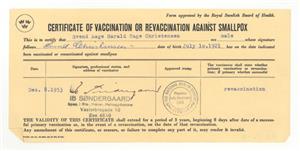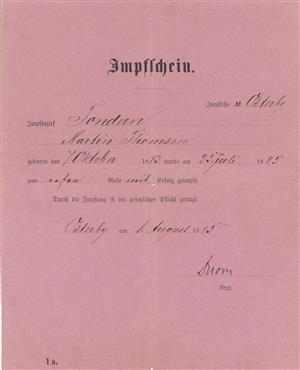Smallpox Vaccination Certificates
Brief Overview
Certificate of smallpox vaccination
18851990.053.007 – Gift of Karen M. Kadgihn
Certificate of vaccination or revaccination against smallpox
19531993.072.009 – Gift of Svend A. Christensen
Share this Resource
Resource Categories
Primary SourcesFear of diseases spreading from immigrants arriving from the old country was always present.
As early as 1647 Massachusetts instituted quarantine on all incoming ships and in 1796 New York instituted a compulsory inspection of all new arrivals.
The passengers bundled together in steerage were considered a particular health risk and with some justification. Tainted water supplies could lead to the rapid spread of cholera epidemics in the crowded and unsanitary quarters.
An 1891 law excluded “persons suffering from a loathsome or dangerous disease” from the United States. Hence all immigrants had to pass through a health inspection upon arrival at Ellis Island, where they were checked for infectious diseases, heart disease, and both mental and physical infirmities. Often the stairs to the inspection hall was the first test. If an individual became out of breath climbing up them it might be a sign of heart trouble and a large H was chalked on their backs.
Immigrants who failed the medical inspections were detained, questioned and faced possible deportation.
As part of the initial medical questioning immigrants had to prove that they had received all necessary vaccinations, including smallpox. It was necessary to be revaccinated against smallpox 10 to 20 years after the original innoculation to be assured of the best effect.
Smallpox innoculation was first discovered in 1796 and as such was the first disease ever to be treated with vaccination and continued to be so until the eventual eradication of the disease in 1979.
Smallpox vaccination certificates can also be a valuable source of information in that they contain the date of birth and give information about the place of birth. The text on the 1885 certificate is in German as it came from a part of Denmark then under German rule. This is sometimes the case with immigrant documents and does not mean the person in question was a German.

